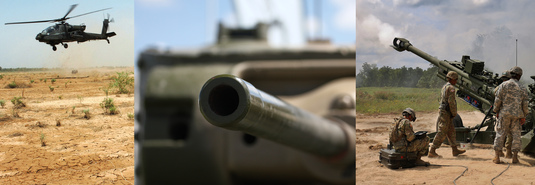International Arms Trade and Intrastate Conflict (IATIC)
International arms trade and intrastate conflicts: Dynamic analyses of arms imports and their effects on conflict potential, risk of conflict outbreak and state repression
Project granted by the German Foundation for Peace Research/Deutsche Stiftung Friedensforschung
Principal investigator: Prof. Dr. Paul W. Thurner
Project team: Dr. Oliver Pamp, Andreas Mehltretter, M.Sc. (Economics), Paul Binder M.A. (Political Science), Camelia Abdelgelil, B.A. (Political Science)
Duration: 2017–2021
Rebels‘ Armament Dataset (RAD)
Project description
Since the beginning of the century, imports of major conventional weapons have been steadily on the rise. Trade in small arms and light weapons has also seen an ongoing surge already since the 1990s. In a similar evolution, the number of violent intrastate conflicts and fatalities have risen, especially in the last 10 years. In 2014, the deadliest year since 1994, over 100,000 have died due to civil conflicts. Public debate about the potentially calamitous effects of the arms trade has intensified in many of the largest exporting nations like Germany, and especially export permissions to autocratic states have drawn stark criticism. However, the political discourse is so far lacking reliable empirical evidence how traded arms actually impact the risks and dynamics of intrastate wars.
The goal of the research project is thus to analyze the effects of the arms trade and military capabilities of governments and rebel groups on intrastate conflicts. Our theoretical starting points are game-theoretical approaches of conflict escalation and avoidance, bargaining and contest function approaches and theories of insurgency and counter-insurgeny. With extensive statistical analyses, it is examined whether and under which conditions arms imports 1) escalate latent intrastate conflicts or contribute to stabilization, 2) increase conflict intensity, 3) prolong or shorten conflicts, and 4) lead to higher extents of repression and human rights violations.
For a complete picture of the military capabilities of the warring parties, the existing datasets on arms trade provided by the Stockholm International Peace Research Institute (SIPRI) and the Norwegian Initiative on Small Arms Transfers (NISAT) are not sufficient, as they do not cover non-state actors comprehensively. Thus, the project collects data on the military endowment of non-state actors by document analysis of multiple informative sources and combining existing data, e.g. from the Small Arms Survey (SAS). The statistical analyses are based on a theoretical model that identifies and parametrizes the effects of arms transfers to conflict countries. The methodological focus in the empirical evaluation lies on dynamic analysis methods that account for the fact that arms imports do not only impact conflicts, but can also be caused by conflicts in the first place. This so-called problem of endogeneity has not been considered sufficiently in studies on these issues so far. To achieve causal identification of the effects of arms imports, the project employs structural equation models and innovative instrumental variable approaches.
The findings of the project will allow to assess how imports of major conventional weapons and small arms affect intrastate conflicts, state repression and human rights violations, and how conflicts in turn impact the demand for weapons transfers. The project thus contributes to the foundational research on arms trade and conflicts. The results are valuable for a wide range of political debates, e.g. on how to design export guidelines that align with ethic criteria for responsible politics of exporting arms. Based on the empirical evidence of this project, political debates and decisions will rely on a much better understanding of potential consequences of arms transfers.
Publications and Working Papers
- Mehltretter, Andreas and Pamp, Oliver and Thurner, Paul and Binder, Paul, Introducing the Rebels Armament Dataset (RAD): Collecting Evidence on Rebel Military Capabilities (August 10, 2023). Available at SSRN.
- Mehltretter, Andreas, Paul W. Thurner, Oliver Pamp, Paul Binder, 2023: Rebels’ Armament Dataset (RAD) Codebook. (Download).
- Racek, Daniel, Paul W. Thurner, Brittany I. Davidson, Xiaoxiang Zhu and Göran Kauermann, 2023: Conflict Prediction Using Remote Sensing Data: An Application to Syria. International Journal of Forecasting.
- Fritz, Cornelius, Marius Mehrl, Paul W. Thurner, Göran Kauermann, 2022: The role of governmental weapons procurements in forecasting monthly fatalities in intrastate conflicts: A semiparametric hierarchical hurdle model. International Interactions 48,4: 778-799.
- Mehltretter, Andreas, Paul W. Thurner, 2021: Duration of Intrastate Wars of Attrition: The Causal Impact of Military Build-Ups. (Paper presented at the Annual Conference of the Midwest Political Science Association Conference 2019, April 6, Chicago, and the Jan Tinbergen European Peace Science Conference 2019, June 25, Den Haag). Available online.
- Mehltretter, Andreas, 2021: Arming for conflict, arming for peace? How small arms imports affect intrastate conflict risk. Conflict Management and Peace Science 39,6: 637-660. (Paper presented at the Conflict Research Society Annual Conference 2017, September 19, Oxford).
- Mehltretter, Andreas, 2021: What Are They Fighting With? The Rebels’ Arms Dataset. (Paper presented at the online Jan Tinbergen European Peace Science Conference 2021, July 1.)
- Mehrl, Marius, Paul W. Thurner, 2020: The Effect of the COVID-19 Pandemic on Global Armed Conflict: Early Evidence. Political Studies Review 19,2: 286-293.
- Mehrl, Marius, Paul W. Thurner, 2020: Military Technology and Human Loss in Intrastate Conflict: The Conditional Impact of Arms Imports. Journal of Conflict Resolution 64,6: 1172-1196.
- Pamp, Oliver, Lukas Rudolph, Paul W. Thurner, Andreas Mehltretter, Simon Primus, 2018: The build-up of coercive capacities. Arms imports and the outbreak of violent intrastate conflicts. Journal of Peace Research 55,4: 430–444.
Photo Credits: Left photo is by "The U.S. Army", obtained from https://www.flickr.com/photos/35703177@N00/543865056 and licensed under CC BY 2.0., Center photo is by Simon Forbes, obtained from https://www.flickr.com/photos/30656615@N05/4226629098 and licensed under CC BY 2.0., Right photo is by "Virginia Guard Public Affairs", obtained from https://www.flickr.com/photos/35101671@N06/36749722631 and licensed under CC BY-NC 2.0.


